Percentage of Students Who Continue for a Master s Degree
Report Highlights. Educational attainment among 25- to 29-year-olds in the United States has risen at every level by as much as 80% since the year 2000.
- 94% of 25- to 29- year-olds have a high school diploma.
- The likelihood an individual will live with a spouse increases with educational attainment by 4%.
- The likelihood an individual will be employed within the civilian workforce increases with educational attainment by 6%.
- For Black and Latino/Hispanic students, there are fewer and fewer students at the higher levels of education – their population size shrinks by 27% at each educational tier.
Related reports include College Graduation Statistics | College Dropout Rates | College Enrollment Statistics
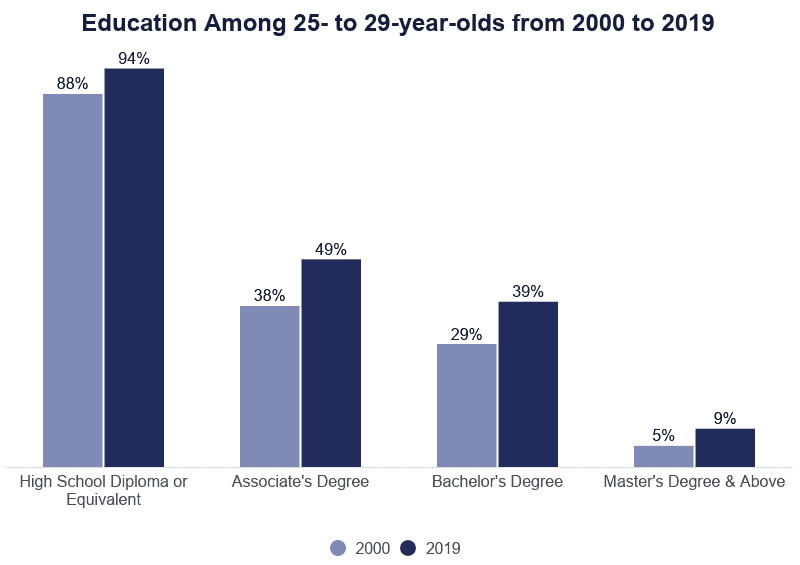
General Statistics
For our purposes, educational attainment refers to the highest completed level of education. A high school graduate or equivalent (ex., GED) with college credits but no degree is counted among high school graduates in the data below. Official sources report data divided into two sex-based categories: male and female. Additional categorical data is unavailable, and the terms "sex" and "gender" are used interchangeably.
- The 9% of Americans who earn a master's degree or higher increase their employability by a little less than 3%.
- Educational success directly correlates with success in marriage and homeownership.
- Gender gaps continue to widen in unexpected ways while racial disparities slowly shrink.
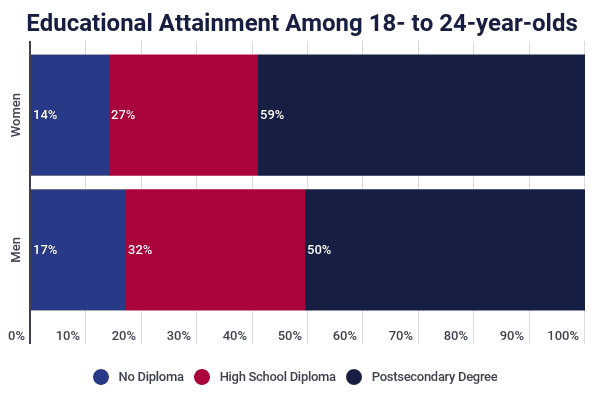
High School Diploma Statistics
The gender gap among high school graduates has stagnated in recent years. In 2019, among high school graduates, the male-to-female ratio was almost 1-to-1. Some racial gaps among high school graduates decreased from 2000-2019. Attainment has improved across the board though disparities remain.
- Data indicates that 60% of 25- to 29-year-olds without a high school diploma or equivalent (such as a General Educational Development certification or GED) achieve that level of education after a few years away from school.
- 86% of 18- to 24-year-old women and 83% of 18- to 24-year-old men have a high school diploma or equivalent.
- Among that group, 69% of the women and 60% of the men go on to higher education before the age of 24.
- While Latino/Hispanic retention increased by 23%, this demographic has yet to attain a graduation rate in the 90th percentile.
- There were also significant increases in attainment among American Indian/Alaska Native and Pacific Islander demographics, which improved by 16% and 15%, respectively.

Occupations for High School Diplomas
About half of high school-level attainers over the age of 25 work in the civilian job force. Their top occupations are service, office and administrative, and transportation and logistics positions. Wholesale retail and trade, education and health, and manufacturing are the industries that employ the largest percentage of this demographic.
- 4% were unemployed.
- 42% were not employed in the civilian labor force.
- 55% were employed as civilians.
Marriage Status Among High School Diploma Holders
In 2019, about half of Americans with a high school attainment level were married. Roughly half owned their own homes, with mortgages averaging $50,000 apiece.
- 54% were married.
- 22% had never married.
- 15% were divorced or separated.
- 9% were widowed.
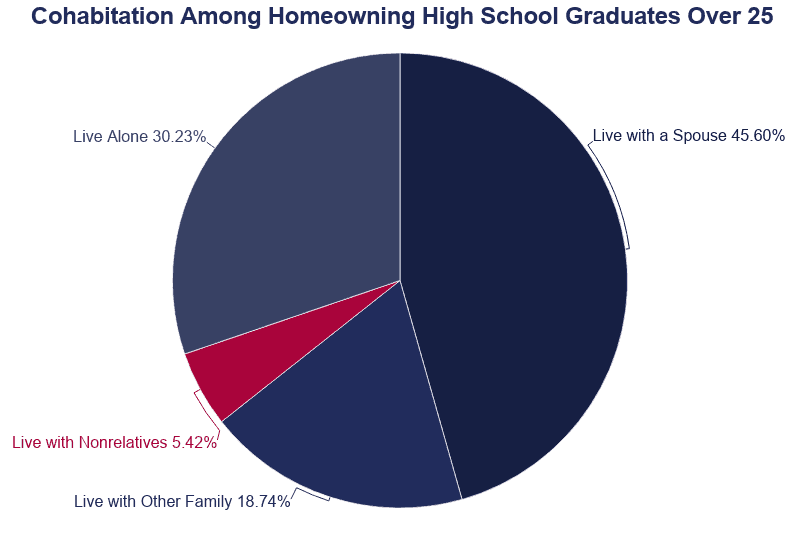
Associate's Degree
The gender gap among those with associate's degrees has increased slightly, from 14% to 18%. In 2019, among associate's degree earners: 44% were men. 56% were women.
- Among 18- to -24-year-old's, 6% of the male population had associate's degrees.
- Among 18- to -24 year old's, 7% of the female population had associate's degrees.
- 45% of the associate degree holders aged 18- to -24 were male.
- 55% of the associate degree holders aged 18- to -24 were female.
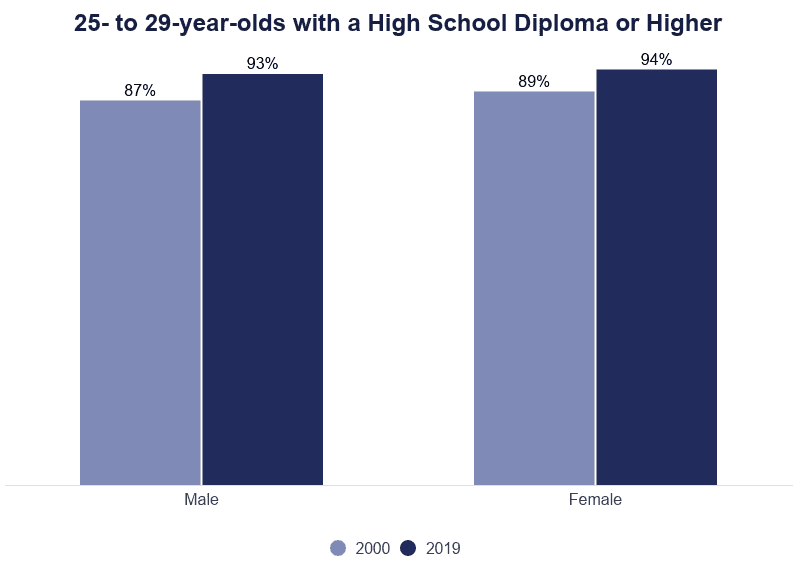
Racial Demographics of Associate Degree Holders
In every racial category, more people are entering post-secondary education. Patterns in race distribution at this level are similar to those at the high school level. Many disparities have either remained level or decreased; think tanks and education specialists attribute decreases to greater understanding of how racial bias in education can degrade student aptitude.
- In the past 20 years, Latino/Hispanic retention has increased by 107%.
- In 2000, White students were almost three times (193%) more likely to earn an associate's degree. than their Latino/Hispanic counterparts.
- By 2019, this gap had narrowed significantly, though White students are still 81% more likely to graduate.
- Similarly, White students' retention rate was 70% higher than Black students' in 2000.
- By 2019, White students' graduation rate was down to 40% higher than their Black counterparts.
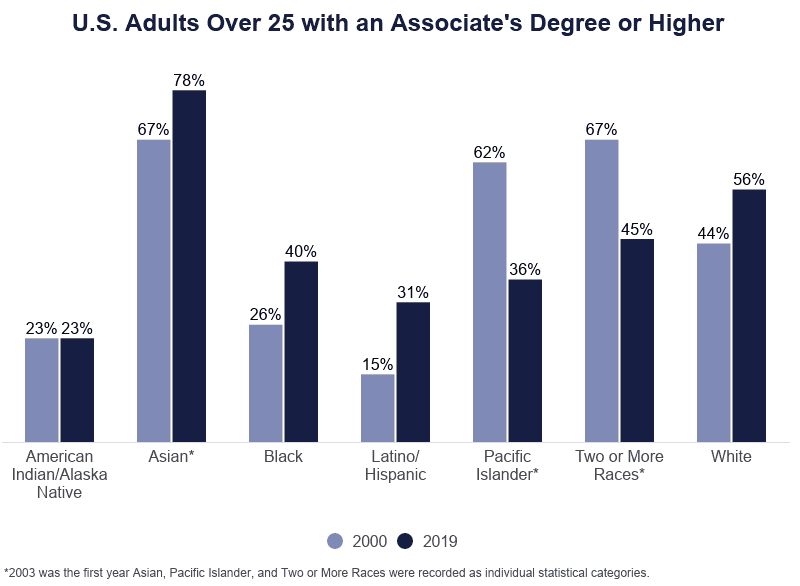
Occupations for Associate degree holders
Unemployment is only 2% for associate's degree holders. While service positions remain among the top three occupations, an associate's degree significantly increases the likelihood of holding a professional or management position.
- The top 3 employing industries are education and health, wholesale retail and trade, and professional and business services.
- 2% were unemployed.
- 31% were not employed in the civilian labor force.
- 67% were employed civilians.
- The majority of associate degree holders – over 28% – work in the educational and health services industry.
- Wholesale and retail, professional and business industries employed the 2nd and 3rd largest blocs of associate degree holders.
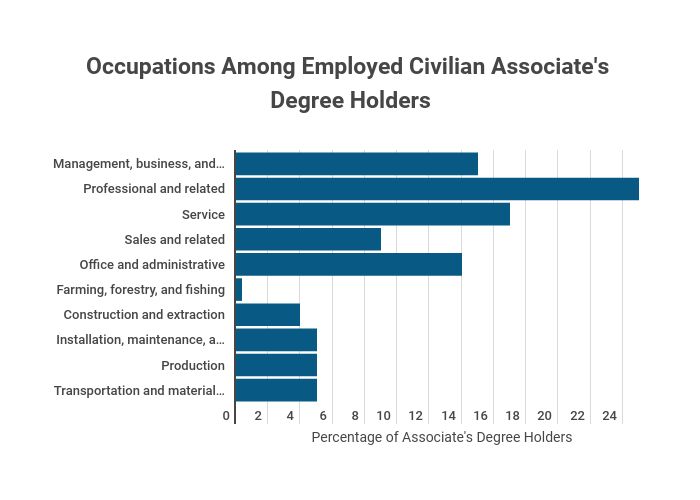
Marriage Status Among Associate's Holders
In 2019, among those with associate's degrees as their highest level of educational attainment, over half were married. Almost 58% owned their own home. Roughly half of associate degree holders lived with a spouse in their own home. A little more than a quarter of home owning associate degree holders lived alone.
- 60% were married.
- 19% had never married.
- 15% were divorced or separated.
- 6% were widowed.
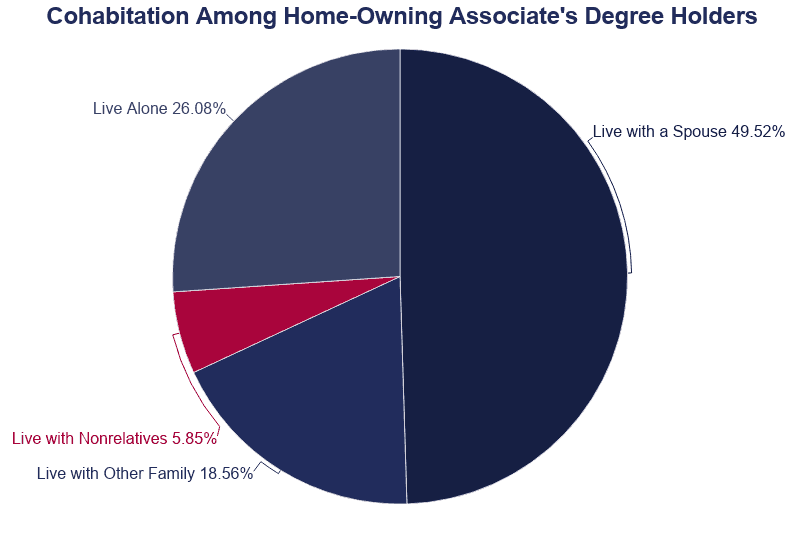
Bachelor's Degree
The gender gap among those with bachelor's degrees has more-than-doubled, increasing from 7% to 17%. In 2019, among bachelor's degree earners: 44% were men. 56% were women.
- Among 18- to -24-year-olds, bachelor's degree earners accounted for 10% of the male population.
- Among 18- to -24-year-olds, bachelor's degree earners accounted for 13% of the female population.
- Bachelor's degree earners were 42% male.
- Bachelor's degree earners were 58% female.
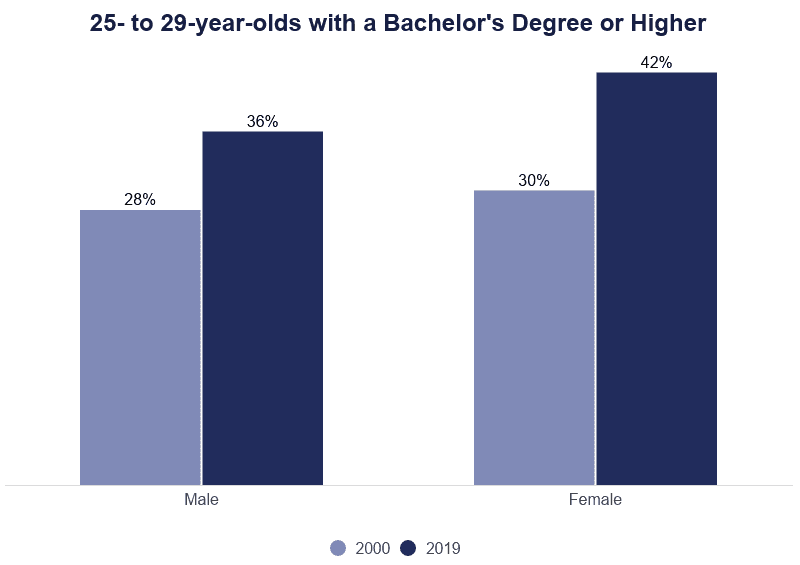
Racial Demographics of Bachelor Degree Holders
Racial inequality is greater among those with bachelor's and higher degrees. Patterns in race distribution at this level are similar to those at lower levels, with Latino/Hispanic retention up by 110%. The gap between Latino/Hispanic and White is still 114%; the gap between White and Black is 55%, shrinking from 89% in 2000.
- In 2019, White 25- to 29-year-olds were 55% more likely than their Black counterparts to have bachelor's degrees or higher.
- In 2000, however, the gap between these groups was closer to 89%.
- Between Whites and Latino/Hispanics in this age group, the 2019 gap was 114%.
- Between Whites and Latino/Hispanics in this age group, The 2000 gap was 240%.
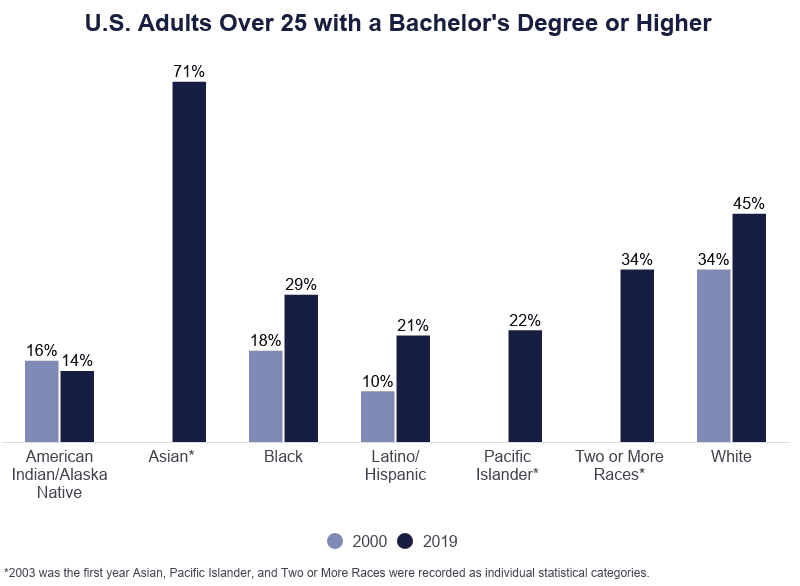
Occupations for Bachelor degree holders
A bachelor's degree significantly increases the likelihood of working in management. In 2019, the top occupations among this demographic include sales and professional titles. Education and health is the top industry.
- 2% were unemployed.
- 27% were not employed in the civilian labor force.
- 72% were employed as civilians.
- The educational and health services industry employs the largest demographic of bachelor degree holders – more than 24%.
- Professional and business industries, and the financial industry are the second and third largest employers of people with a bachelor's degree.
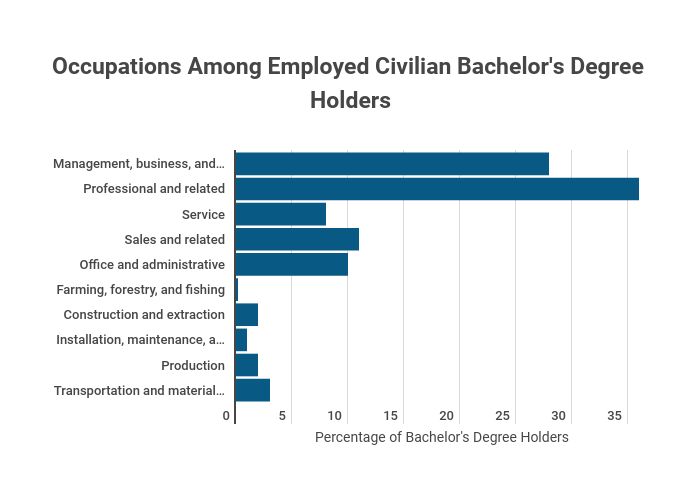
Marriage Status Among Bachelor's Holders
In 2019, among those with bachelor's degrees as their highest level of attainment, more than half lived with a spouse. More than a quarter of bachelor degree holders lived alone.
- 64% were married.
- 21% had never married.
- 11% were divorced or separated.
- 4% were widowed.
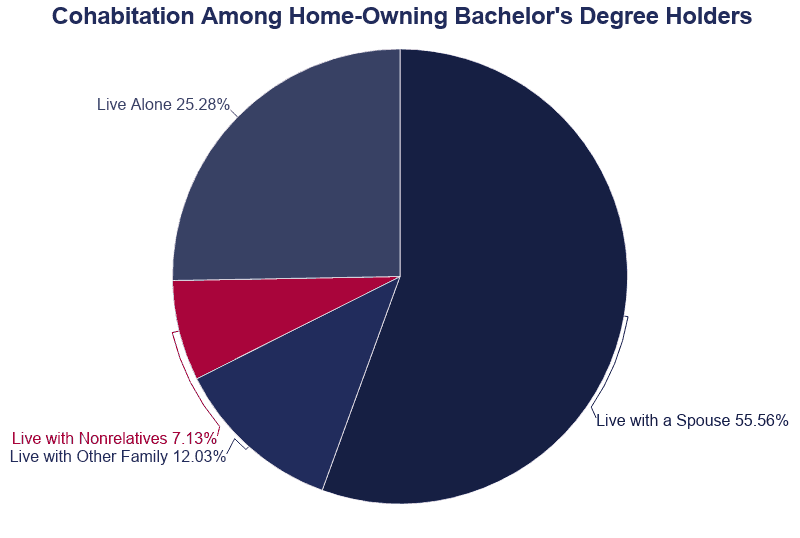
Master's Degree and Higher
The gender gap among those with a master's degree or higher has widened in two ways. In 2019, among advanced degree earners: 47% were men. 53% were women.
- The gender gap favored women by 12%.
- The gender gap increased from 20% to 38%, favoring women.
- Among those over 25 years who held a Doctoral or Professional degree as of 2019 – 57% were men.
- Among those over 25 years who held a Doctoral or Professional degree as of 2019 – 33% were women.
- The gender gap among those over 25 years old favored men by 73%.
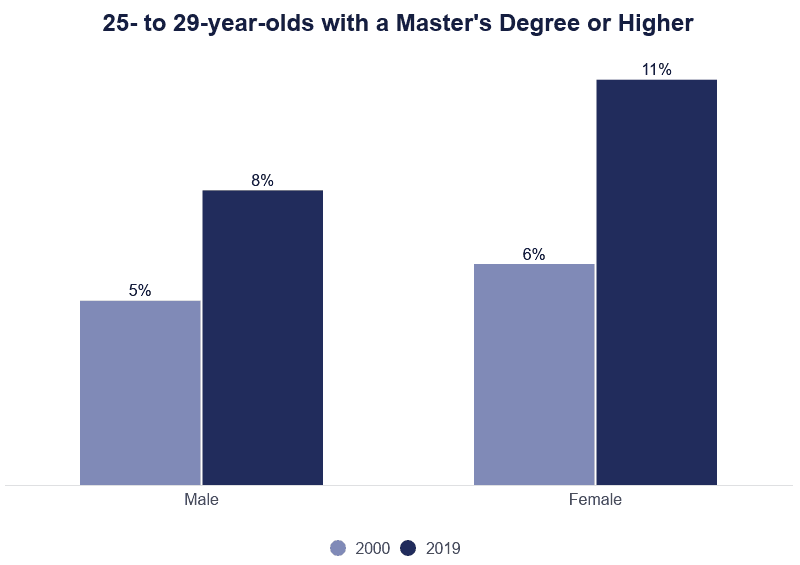
Racial Demographics of Master's Degree Holders and Higher
Racial inequality is worst at the highest education levels. There are few statistics available regarding race and ethnic distribution at this level, so it is difficult to detect patterns.
- Asians are 5 times more likely than Latino/Hispanics to hold an advanced degree.
- Asian attainment is at least 92% higher than other races.
- The gap between White and Black is 44%, which is the 2nd widest after the Bachelor level.
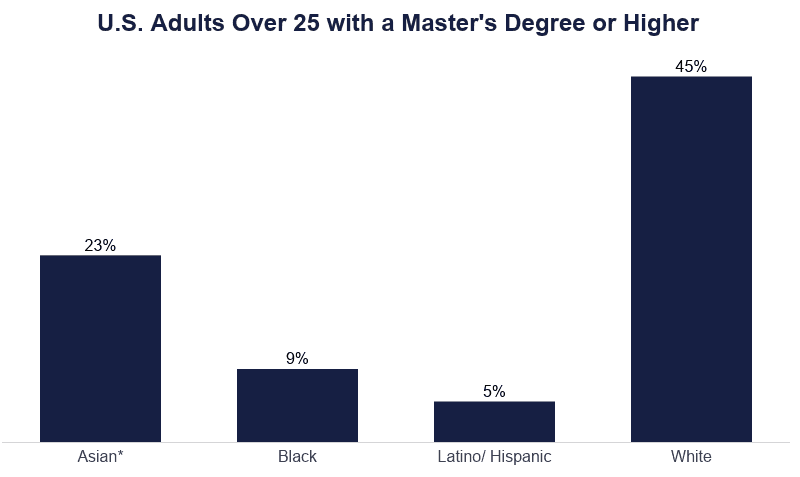
Occupations for Master Degree Holders and Higher
Master's and Professional degree-holders have the lowest unemployment rates. The majority of individuals with master's degrees or higher work in professional and related occupations. Farming, forestry, and fishing occupations employed the fewest amount of people with a master's degree or higher.
- 1% were unemployed.
- 25% were not employed in the civilian labor force.
- 73% were employed as civilians.
- More than 55% of master degree holders work in occupations classified as professional or related.
- Similarly, more than 70% of doctorate and professional degree holders work professional or related occupations.
- The second largest group of master degree holders work in management, business, or related occupations – roughly 30%.
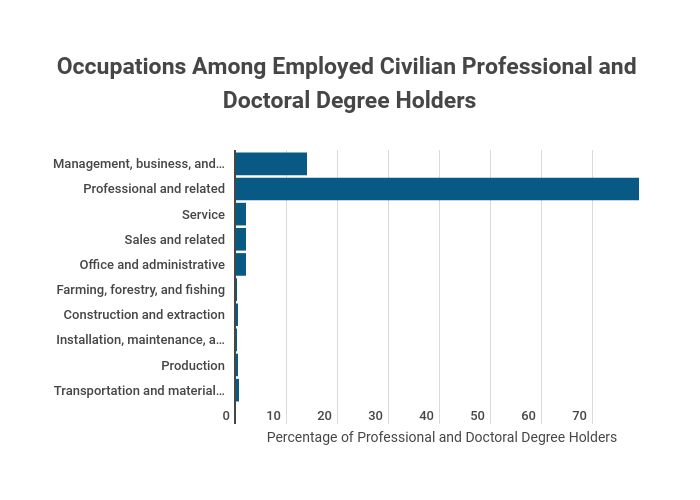
Marriage Status Among Master's Degree Holders or Higher
Higher education seems to correlate with personal success. Professional and doctoral degree holders are also most likely to be married and own their own homes.
- 71% were married.
- 16% had never married.
- 9% were divorced or separated.
- 4% were widowed.
- 46% of home owners with a master's degree live with a spouse.
- 26% of home owners with a master's degree live alone.
- 21% of home owners with a master's degree live with nonrelatives.
- 7% of home owners with a master's degree live with other family.
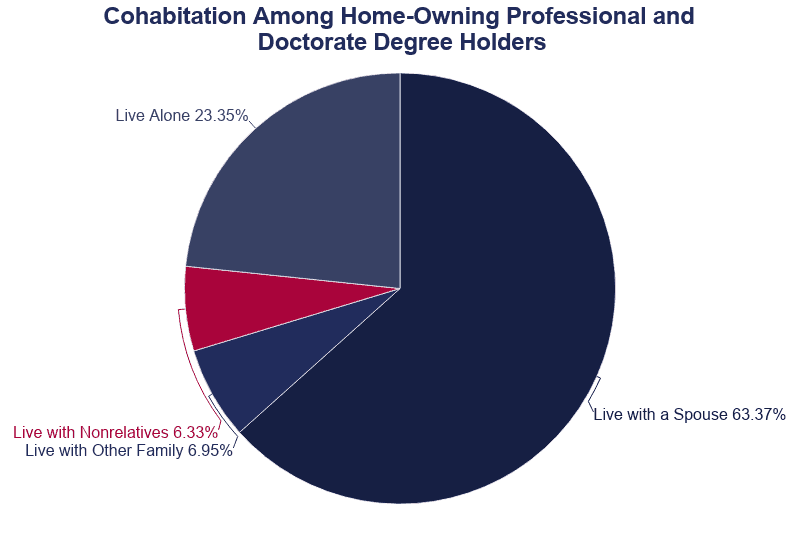
Sources
- National Center for Education Statistics (NCES): Fast Facts- Educational Attainment
- National Center for Education Statistics (NCES): Annual Reports – Educational Attainment of Young Adults
- United States Census Bureau: Educational Attainment
- iPropertyManagement: Homeownership Rate by Age
- MarketWatch: The Higher Your Degree the More Likely You Are to Buy a House
- U.S. Department of Commerce: Spotlight on U.S. Educational Attainment
- U.S. Bureau of Labor Statistics: Earnings and unemployment rates by educational attainment, 2020
- American Council on Education: Educational Attainment, by Race and Ethnicity
meisnerbobbled1985.blogspot.com
Source: https://educationdata.org/education-attainment-statistics
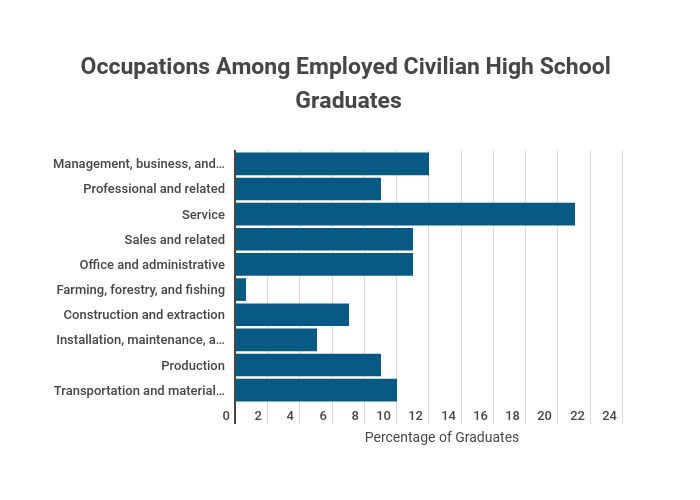
Belum ada Komentar untuk "Percentage of Students Who Continue for a Master s Degree"
Posting Komentar